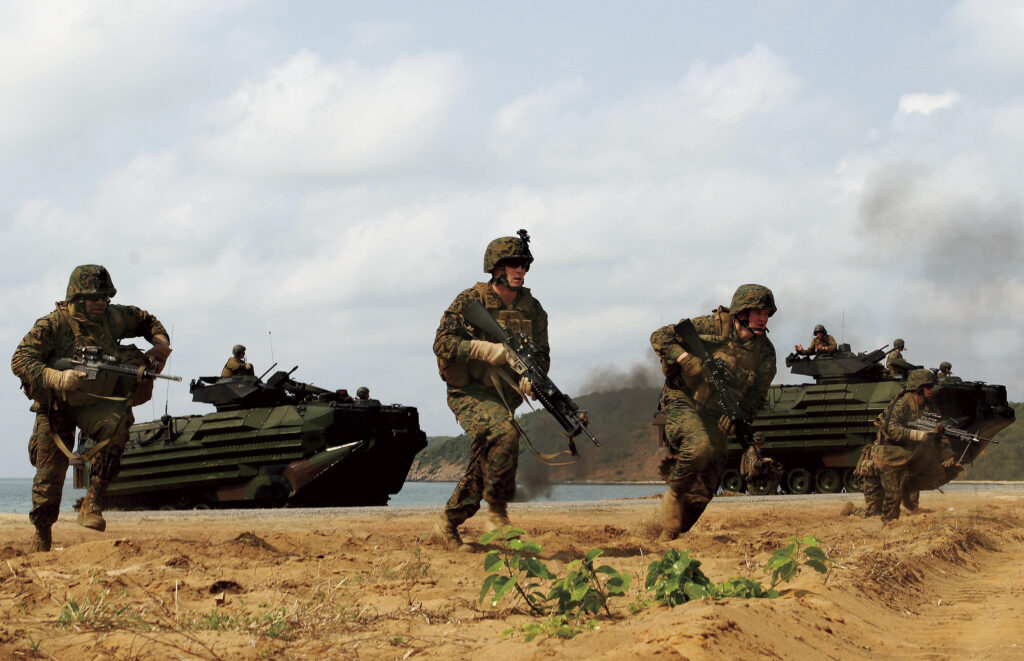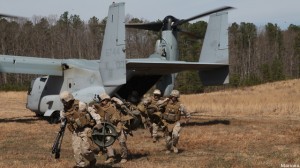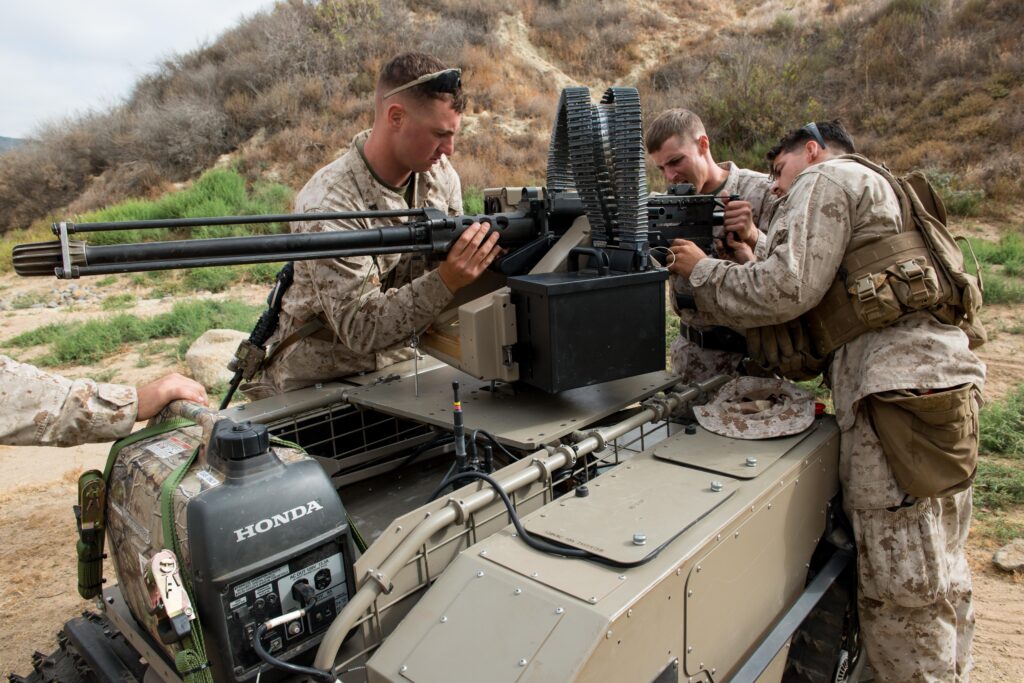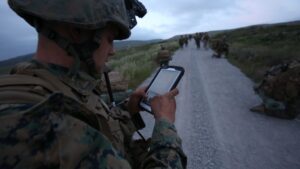Marines Rush 50 Technologies To Field Test In 9 Months
Posted on

Marines will experiment with self-driving versions of their venerable Amphibious Assault Vehicle (AAV), shown here, in April wargames at Camp Pendleton in California.
QUANTICO: Marines at Camp Pendleton will get to field-test more than 50 different new technologies next month ranging from palmtop mini-drones to self-driving amtracs, from wireless networks to precision-guided mortar shells. Plus there will be plenty of classified systems the Marines can’t talk about, including cyber and electronic warfare gear. Technologies that do well may graduate to a more formal Operational Evaluation (OPEVAL) or to further testing in the Marines’ big Bold Alligator wargame on the East Coast this fall, Col. Dan Sullivan, chief of staff at the Marine Corps Warfighting Laboratory here, told reporters today.

Marines landing from a V-22 Osprey tiltrotor.
(The name of April’s exercise, in classically military fashion, is — deep breath — the Ship To Shore Maneuver Exploration and Experimentation Advanced Naval Technology Exercise 2017, or S2ME2 ANTX).
That’s a lightning pace for the Pentagon. It normally takes 18 to 24 months to set up a technology demonstration on this scale, and this one is happening in nine, said Aileen Sansone, an official with the Navy’s Rapid Prototyping, Experimentation, & Demonstration (RPED) office. The project launched last summer, when Col. Sullivan’s boss, Lt. Gen. Robert Walsh — in charge of future warfare concepts — reached out to deputy assistant secretary John Burrow — in charge of R&D, testing, and evaluation.
It was only in October that the project team put out its special notice inviting industry proposals. Well over 100 operators and engineers from different Navy and Marine Corps organizations evaluated the 124 (unclassified) submissions and whittle them down to 50 that would ready for the field by April, said Navy Capt. Chris Mercer, Burrow’s director of RPED. (Another 50 technologies, not quite as ready, will be on display for visiting dignitaries but won’t be used in the exercise).
“It drives the analysts crazy. Analysts don’t like to go fast,” Sullivan chuckled to reporters. “Are you accepting risk? Yes, you are.”

Sean Stackley
Some of the 50 technologies will probably just plain not work, the team told reporters, and that’s okay. In fact, failing “early and often” is an essential part of innovation. “If we don’t fail, we didn’t do our job,” said Mercer. “This is the time to fail” — before the Marines decide on major acquisition programs, let alone take a technology into combat.
The project has high-level support to take that risk, including the enthusiastic backing of acting Navy Secretary Sean Stackley, who used to head Navy Department Research, Development, & Acquisition (RDA).
“This exercise provides a unique opportunity for warfighters to assess emerging technologies and innovative engineering in support of amphibious assault operations,” Stackley said in a statement to Breaking Defense. “We are grateful to the government and industry vendors who participate and bring their expertise to assist in supporting our nation’s security.”
“SecNav’s committed to (1) really accelerating the rate of our innovations and (2) using the new authorities that have been coming to use since about 2015 to really rapidly prototype and rapidly field,” said Mercer. But even as you go fast, he added, you have to make sure “you’ve got the rigor in the process that allows us to use the new authorities.”

Marines work on armed MUTT robot in the MIX-16 experiment.
Six Missions
So what kinds of capabilities will this project deliver to the field? Almost all of them rely on rapid advances in information technology, and many are outright robotic, like the various drones and self-driving Amphibious Assault Vehicle. There’s no single silver bullet, Sullivan and co. said, and the real tactical payoff comes from combining technologies. That’s why the Marines organized the experiment not by technical categories — e.g. one team handles all unmanned aerial vehicles, another unmanned watercraft, another networks — but by mission, which required experts in different fields from different agencies and companies to integrate disparate technologies towards a single purpose.

A Marine Infantry Officer’s Course student uses a commercial tablet in an experimental exercise.
The team defined six mission areas and gave them nifty codenames:
- Shield: “early intelligence (and) reconnaissance,” using, for example wide-ranging swarms of robotic scouts in the air, sea, and land, which would allow Marines to identify far more landing sites and potentially bypass defenders by coming ashore in unexpected places. Instead of landing en masse at an obvious 1,000-meter-wide beach, said the Warfighting Lab’s Doug King, “I want to go through a gap in the mangroves.”
- Spear: “threat identification,” e.g. covert drones coming in for a closer look with high-powered sensors and sending detailed data back using hard-to-intercept transmissions.
- Dagger: “(follow-on) reconnaissance & threat elimination,” e.g. more drones and manned platforms marking obstacles and mines.
- Cutlass: “maneuver ashore,” e.g. unmanned boats carrying Marines ashore at high speed or unmanned amtracs swimming in on their own power, with expendable decoy drones.
- Broadsword: “combat power ashore,” e.g. battlefield 3D printing of spare parts and unmanned ground vehicles providing fire support or carrying supplies.
- Battleaxe: “amphibious C4ISR (Command, Control, Communications, Computers, Intelligence, Surveillance, & Reconnaissance),” e.g. high bandwidth networks, resisting to jamming and hacking, that can tie the whole operation together.
Because of the laser focus on amphibious landings, the Ship to Shore Maneuver task force deliberately didn’t look at other promising technologies, such as, well, lasers. For operations at sea, the Navy already has a drone-killing laser aboard a ship in the Persian Gulf, while the Marines are developing a truck-mounted laser for air defense ashore. Likewise, Sullivan said, the “Sea Dragon” effort with 3rd Battalion, 5th Marine Regiment is focused more on smaller technologies that a Marine squad can carry with it once it’s landed ashore.

Chinese weapons ranges (CSBA graphic)
What the Ship to Shore Maneuver task force has taken on is the defining task of the Marine Corps: amphibious landing in the face of armed resistance. That’s especially hard when the armed opposition now has so-called Anti-Access/Area Denial defenses: precision-guided cruise missiles with hundreds of miles of range, strike aircraft, submarines, drones, with the sensors to find targets and the networks to coordinate them.
“Our generation grew up in an environment where we were the only ones who had precision guided munitions. We were the only ones who had UAS (drones). Air supremacy was guaranteed; maritime supremacy was taken for granted,” Sullivan said. That’s changed.
“For a long time, we were talking about countering shore-based defenses by standoff, but anti-ship cruise missiles (are) just going to continue to extend the range, so we’re going to have to get and persist within that envelope — and if you look at the totality of the capabilities that we’re experimenting, it’s giving us the ability to do that,” Sullivan said.
“At some point, we’ve got to dismantle the A2/AD integrated defense system,” said Sullivan. “To be considered a great power, you have to be retain a forcible entry capability.”
Subscribe to our newsletter
Promotions, new products and sales. Directly to your inbox.
